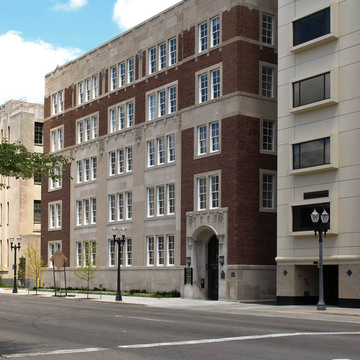You are here
Christman Building (Mutual Building)
In a demonstration of its commitment to integrated and sustainable design and construction, to historic preservation, and to the downtown revitalization of the company's home city, Christman Company relocated its national headquarters to the former Mutual Building. This important construction firm was established in Lansing in 1894.
Built to house the headquarters of Michigan Millers Mutual Fire Insurance Company, the five-story, U-shaped, red brick limestone-trimmed office building was sited nearly across from the southeast corner of the Michigan State Capitol grounds. In their design Pond and Pond employed a hint of Collegiate Gothic the firm used more overtly on the Michigan State University Memorial Union ( IN17.3).
SmithGroup, who frequently collaborates with Christman Company on historic preservation projects, planned the rehabilitation. The exterior and key contributing interior features—the main stairway, corridor, and first-floor paneled offices—were restored. Also restored were the mica-shade light fixtures, Pewabic tiles laid in walls of the main floor, and verdigris bronze handrail finish of the main staircase. Between the arms of the U, the architects added a sixth floor and a skylighted atrium that is accessible to this floor and to floors four and five. The sixth floor is not visible from the street, but it affords views of the capitol and city. The white roof that deflects heat, energy-efficient windows, under floor air distribution system, natural interior light, and other conservation measures yielded the rehabilitation U.S. Green Building Council LEED Platinum Certification in 2008.
Writing Credits
If SAH Archipedia has been useful to you, please consider supporting it.
SAH Archipedia tells the story of the United States through its buildings, landscapes, and cities. This freely available resource empowers the public with authoritative knowledge that deepens their understanding and appreciation of the built environment. But the Society of Architectural Historians, which created SAH Archipedia with University of Virginia Press, needs your support to maintain the high-caliber research, writing, photography, cartography, editing, design, and programming that make SAH Archipedia a trusted online resource available to all who value the history of place, heritage tourism, and learning.















